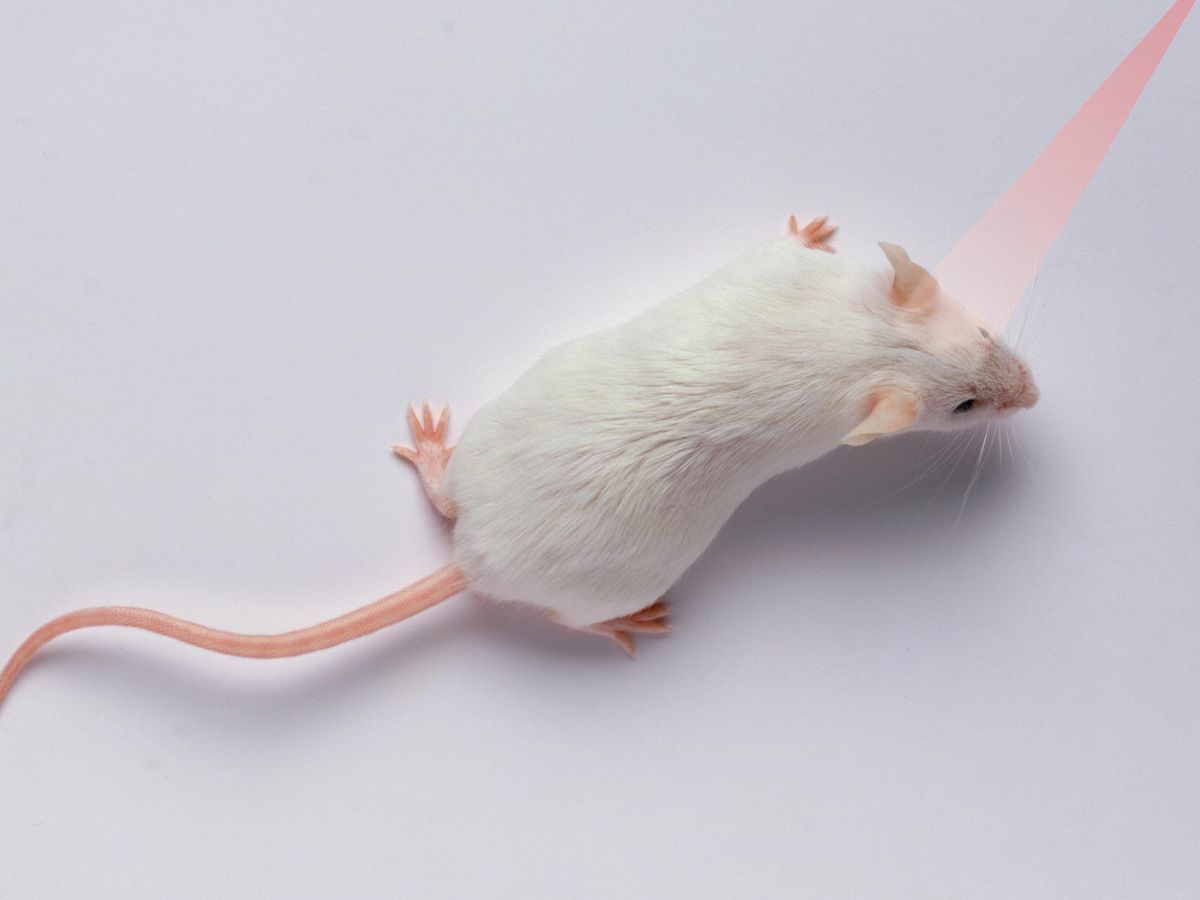For the first time, scientists have invented a noninvasive way to control the brain circuits—the clusters of neurons in the brain that collectively perform a specific task—of freely moving lab animals from a distance. The new technique, which beams near-infrared light into the brain, may help researchers analyze how the brain works during normal behavior, and may one day lead to new treatments for brain diseases in people.
The findings detailed in the new study in the 21 March Nature Biomedical Engineering build on work conducted over roughly 20 years in optogenetics, a technique that uses bursts of visible light to control the activity of cells genetically modified to respond to illumination. Scientists have used optogenetics to analyze brain circuits in mice and other lab animals to shed light on how they might work in humans.
However, existing optogenetics techniques are often limited in what they can accomplish because of their reliance on visible light. The brain is quite opaque to visible light, so getting the light to the neurons that researchers want to target usually requires invasive implants and skull-mounted fiber-optic cables, “which inevitably cause brain damage or alter the animal’s behavior,” says study co-lead author Xiang Wu, a materials scientist and neural engineer at Stanford University.

In a new study, researchers overcame this problem with the use of near-infrared light—specifically, wavelengths ranging from 1,000 to 1,700 nanometers, known as near-infrared II—to which biological tissues, including the brain and skull, are essentially transparent. This makes it possible to deliver such light much deeper into the brain.
First the scientists genetically modified cells to produce a molecule known as TRPV1. This heat-sensitive protein helps people feel heat-related pain, as well as the spicy burn of chili peppers, and its discovery received the Nobel Prize in Medicine in 2021. A similar molecule gives rattlesnakes and other pit vipers the ability to hunt warm-blooded prey in the dark.
The researchers also developed nanoparticles that could absorb near-infrared II light and convert it to heat that TRPV1 could sense. These roughly 40-nanometer-wide particles, dubbed MINDS, for “macromolecular infrared nanotransducers for deep-brain stimulation,” are made from biodegradable polymers used to produce organic solar cells and LEDs.
In experiments on mice, the scientists genetically modified neurons on just one side of the motor cortex, which controls the locomotion of these rodents, and injected MINDS into the same region. Normally, the mice explored their enclosures at random, but when near-infrared II lights were switched on over them, they started walking around in circles, driven by the one-sided stimulation of the motor cortex.
The researchers found they could also use their new technique on reward-linked neurons located near the base of mouse brains deep within their skulls. This essentially made the rodents addicted to near-infrared II light, spending nearly all their time in portions of mazes lit by such light, and showed the method could target neurons anywhere in the brain, even when the near-infrared II lights were positioned as far as a meter above the heads of the animals.
This new way of noninvasively controlling specific brain circuits may help scientists understand the foundations of natural behaviors in mice that they might not be able to investigate with optogenetics due to tethers and brain implants getting in the way.
“One can potentially track the motion of multiple interacting animals with several near-infrared II beams to modulate their neural activities independently,” Wu says. “This is particularly difficult in conventional fiber-based optogenetics, as fibers can restrain the animal behaviors, and mice tend to bite them.”
In addition, “our lab is currently working on developing new techniques that can sensitize neurons to radio waves,” Wu says. “This requires the design of brand-new material systems and quite some engineering efforts.”
The scientists note that their new technique still requires invasive brain surgery to deliver gene-modifying viruses and the MINDS into the brain. Wu notes that in the future, they could make their method less invasive with the help of ultrasound, which can help open the blood-brain barrier—the protective membrane that prevents most larger molecules from entering the brain—so that viruses and MINDS can get delivered into the brain via injections to the body instead.
The researchers caution that “we definitely cannot control a human brain with just a snap of a finger with this technique,” Wu says. “Although we would love to further develop this technique as a treatment for neurological diseases in clinics, there would be tons of work to do before that.”
- New Buzz on Brain Stimulation for Depression - IEEE Spectrum ›
- How Do Neural Implants Work? - IEEE Spectrum ›
- Deep Brain Stimulation Improves Paralyzed Rat's Gait - IEEE ... ›
- Treating Depression With Deep Brain Stimulation Works—Most of ... ›
- Researchers Invent New Method for Non-Invasive Deep Brain ... ›
Charles Q. Choi is a science reporter who contributes regularly to IEEE Spectrum. He has written for Scientific American, The New York Times, Wired, and Science, among others.



